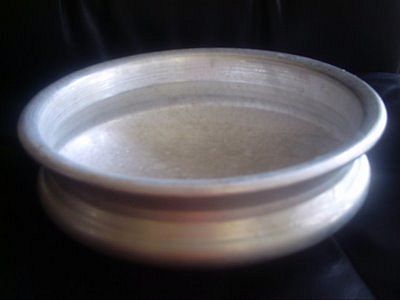Bhagavathi Sevai Payasam
Category:
Sweet, Kerala

Meera was born and brought up in Madras, Tamil Nadu. She graduated from Stella Maris College with a BA in Sociology, and got her MBA from the Asian Institute of Management, Manila. She has enjoyed living in Manila, Istanbul and Hong Kong, and currently lives in a suburb of Washington, D.C. with her husband and two sons.
My parents, Brahmins from Palghat, Kerala, were great devotees of Goddess Durga. In the 1970s, they often conducted Bhagavathi Sevai, a special puja for Goddess Durga, at our home in Madras on Friday evenings. I fondly remember the excitement of the preparations as well as the hustle and bustle of the extended family.
My father conferred with the vadhyar (priest) to prepare for the veneration. My mother went to the Mylapore market to buy the fruits and vegetables, flowers, banana leaves, cotton wicks, camphor, kumkum and rose garlands. She hired a cook to help prepare the elaborate evening meal, while her brother, Raasha mama, made the Bhagavthi payasam, also called nei payasam, the traditional sweet offering (prasadam) in the Kerela Durga temples.

The nei payasam was made on the kumutti (a charcoal grill) in an uruli - a heavy brass utensil used in Kerala.
Raasha mama spent his entire evening stirring and slow cooking it in our back yard, smoking irreverently as he toiled.
As the puja came to an end, the priest would offer (betel leaves and nut), pazham (fruit) and the delectable nei payasam to the Goddess. Then we would get to eat it!
Nei Payasam, very sweet and filled with ghee, is meant to be eaten in small quantities. Serves 7-10.
Ingredients
- 1 cup Rice
- 6 cups Jaggery (gur गुड़)
- 1 to 1½ cups Ghee
- Cashew pieces
- Small chopped pieces of coconut (fresh or dry)
Method
Cook the rice such that the grains are separate, not over-cooked or sticky.
Chop up the jaggery. Place it in a heavy bottomed utensil and add enough water to cover it. Cook on medium heat until the jaggery melts.
Add the cooked rice to the jaggery syrup. Continue cooking on low heat. Keep the mixture lubricated by adding the ghee at frequent intervals. Keep stirring as the water evaporates and the bubbles splatter furiously.
The payasam is done when it slides off easily from the ladle. Remove from heat, and watch a thin layer of ghee float to the top when you stop stirring.
In another pan, fry the cashew and coconut pieces in ghee, and add to the payasam.
Serve hot.
© Meera Balasubramanian, USA, 2008
Comments
Add new comment